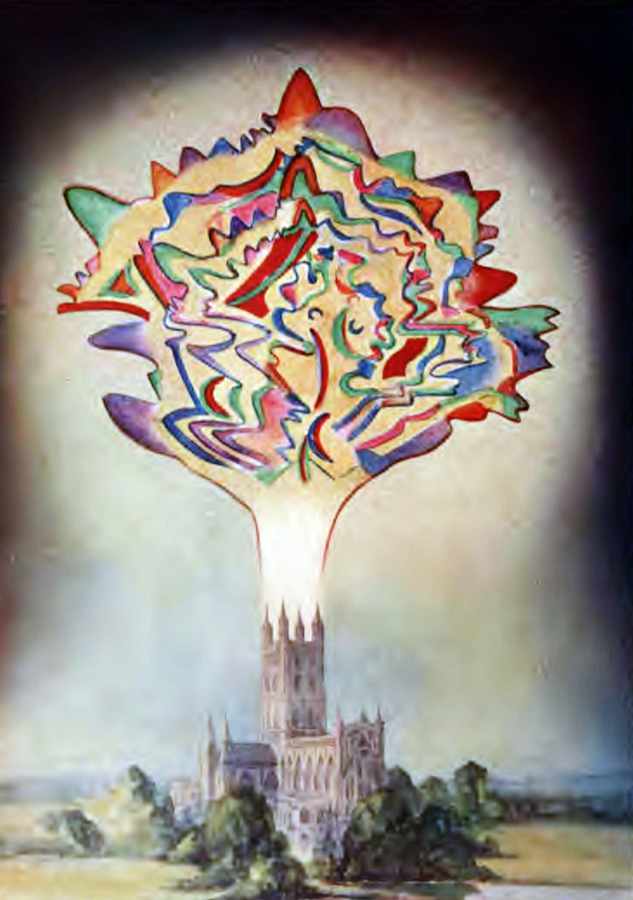Tulpa is a concept in Theosophy, mysticism, and the paranormal, of an object or being that is created through spiritual or mental powers. Modern practitioners, who call themselves “tulpamancers”, use the term to refer to a type of willed imaginary friend which practitioners consider to be sentient and relatively independent. 20th century Theosophists adapted the Vajrayana concept of the emanation body into the concepts of “tulpa” and “thoughtform”. The Theosophist Annie Besant, in the 1905 book Thought-Forms, divides them into three classes: forms in the shape of the person who creates them, forms that resemble objects or people and may become ensouled by nature spirits or by the dead, and forms that represent inherent qualities from the astral or mental planes, such as emotions. The term “thoughtform” is also used in Evans-Wentz’s 1927 translation of the Tibetan Book of the Dead. The concept is also used in the Western practice of magic. Occultist William Walker Atkinson in his book The Human Aura described thoughtforms as simple ethereal objects emanating from the auras surrounding people, generating from their thoughts and feelings. He further elaborated in Clairvoyance and Occult Powers how experienced practitioners of the occult can produce thoughtforms from their auras that serve as astral projections which may or may not look like the person who is projecting them, or as illusions that can only be seen by those with “awakened astral senses”. Spiritualist Alexandra David-Néel stated that she had observed these mystical practices in 20th-century Tibet. She described tulpas as “magic formations generated by a powerful concentration of thought.” David-Néel believed that a tulpa could develop a mind of its own: “Once the tulpa is endowed with enough vitality to be capable of playing the part of a real being, it tends to free itself from its maker’s control. According to David-Néel, this happens nearly mechanically, just as the child, when her body is completed and able to live apart, leaves its mother’s womb.” She said she had created such a tulpa in the image of a jolly Friar Tuck-like monk, which later developed a life of its own and had to be destroyed. David-Néel raised the possibility that her experience was illusory: “I may have created my own hallucination”, though she said others could see the thoughtforms that she created.
| Alias Tulpa |
| Real Names/Alt Names N/A |
| Characteristics Paranormal Mysteries, Ghost, Occult, Astral Projectionist, Prehuman Epoch |
| Creators/Key Contributors ○ |
| First Appearance Tibetan Buddhism |
| First Publisher ○ |
| Appearance List Thought-Forms (1905) by Annie Besant & C. W. Leadbeater [Internet Archive]; The Human Aura: Astral Colors and Thought Forms (1916) by Swami Panchadasi (pseud. of William Walker Atkinson) [Internet Archive]; Clairvoyance and Occult Powers (1916) by Swami Panchadasi (pseud. of William Walker Atkinson) [Internet Archive]; Mudrās: The Ritual Hand-Poses of the Buddha Priests and the Shiva Priests of Bali (1924) by Tyra de Kleen [Google Books]; The Tibetan Book of the Dead (1927) ed. W. Y. Evans-Wentz, translated from Lama Kazi Dawa-Samdup — cornerstone Tibetan source [Internet Archive]; With Mystics and Magicians in Tibet (1931, Eng. ed.; orig. Fr. 1929 Mystiques et magiciens du Tibet) by Alexandra David-Néel — most-cited early Western account describing tulpas; Tulpa Creation Guide (2016) by Thunderclap — modern tulpamancy community guide [Internet Archive. |
| Sample Read With Mystics And Magicians In Tibet (1931) [Internet Archive] |
| Description Tulpa is a concept in Theosophy, mysticism, and the paranormal, of an object or being that is created through spiritual or mental powers. Modern practitioners, who call themselves “tulpamancers”, use the term to refer to a type of willed imaginary friend which practitioners consider to be sentient and relatively independent. 20th century Theosophists adapted the Vajrayana concept of the emanation body into the concepts of “tulpa” and “thoughtform”. The Theosophist Annie Besant, in the 1905 book Thought-Forms, divides them into three classes: forms in the shape of the person who creates them, forms that resemble objects or people and may become ensouled by nature spirits or by the dead, and forms that represent inherent qualities from the astral or mental planes, such as emotions. The term “thoughtform” is also used in Evans-Wentz’s 1927 translation of the Tibetan Book of the Dead. The concept is also used in the Western practice of magic. Occultist William Walker Atkinson in his book The Human Aura described thoughtforms as simple ethereal objects emanating from the auras surrounding people, generating from their thoughts and feelings. He further elaborated in Clairvoyance and Occult Powers how experienced practitioners of the occult can produce thoughtforms from their auras that serve as astral projections which may or may not look like the person who is projecting them, or as illusions that can only be seen by those with “awakened astral senses”. Spiritualist Alexandra David-Néel stated that she had observed these mystical practices in 20th-century Tibet. She described tulpas as “magic formations generated by a powerful concentration of thought.” David-Néel believed that a tulpa could develop a mind of its own: “Once the tulpa is endowed with enough vitality to be capable of playing the part of a real being, it tends to free itself from its maker’s control. According to David-Néel, this happens nearly mechanically, just as the child, when her body is completed and able to live apart, leaves its mother’s womb.” She said she had created such a tulpa in the image of a jolly Friar Tuck-like monk, which later developed a life of its own and had to be destroyed. David-Néel raised the possibility that her experience was illusory: “I may have created my own hallucination”, though she said others could see the thoughtforms that she created. |
| Source Tulpa – Wikipedia |

